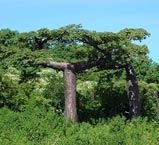|
DIEGO'S BAOBAB
Common Name: Diego's Baobab or Suarez baobab (English), bojy or bozy (Malagasy)
Scientific Name: Adansonia suarezensis
Introduction
Upside down’ baobabs are instantly recognisable, with massive swollen trunks which help them store water in dry conditions and a small crown of horizontal branches. They have many uses for the local people. Madagascar is home to six out of eight of the world’s Adansonia species, all six of which are endemic. Adansonia suarezensis grows in a small area in the north, where it is threatened by habitat degradation.
Why is this species important?
Madagascar is a centre of diversity for Adansonia. All six species are adapted to slightly different niches and grow in different parts of the island. A. suarezensis plays an important role in the lifecycle of several other endemic Malagasy species, including fruit bats, sunbirds, hawkmoths and lemurs and is used in several ways by local people.
Where is it found?
This species is restricted to the very northern most part of Madagascar. There are only two known populations: one in the Baie d’Antiseranana region (previously Diego-Suarez) and another in the Mahory forest. It grows in mixed deciduous forest and particularly over limestone, sometimes growing straight into rocky crevices.
How do people use it?
Both the fruit and seeds are eaten locally, and the seeds are used to produce cooking oil. An infusion of the bark has been used as a treatment for diabetes.
Large baobabs are often considered to be important landmarks, acting as meeting points or resting places. The trunks often become hollow with age and may be used as water cisterns or shelters for people or animals.
The fibres from the bark are used to make rope, and are thought to be stronger than other species of Adansonia, fetching a higher price at market. Baobabs can tolerate the stripping of the bark all around the trunk with no apparent ill effects.
Why is it threatened?
Being confined to a small area, A. suarezensis is particularly vulnerable to habitat degradation. The Baie d’Antiseranana region suffers from deforestation – the trees are felled for firewood and charcoal. Only the population in the Mahory forest shows signs of healthy regeneration but this is close to a rapidly expanding mining town.
What conservation action is needed?
Adansonia suarezensis is the only Malagasy baobab which is not protected inside a nature reserve. While the baobabs themselves are useful to people and therefore not felled, habitat restoration is necessary if the trees are to regenerate.
Selected References
GE Wickens & P Lowe (2008), The Baobabs: Pachycauls of Africa, Madagascar and Australia,.
Springer
D Baum (1995) A systematic revision of Adansonia (Bombacaceae). Annals of the Missouri Botanical Garden 82: 440-470.
Acknowledgements
This tree profile was researched and written by Beccy Middleton.
Photo by Masindrano, via Wikimedia Commons
Back to Tree Profiles
|
CONSERVATION STATUS:
Endangered

|



